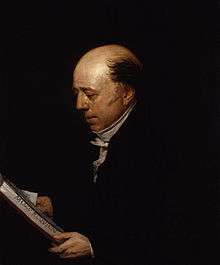Vincent Novello

Vincent Novello (6 September 1781 – 9 August 1861), English musician, son of an Italian who married an English wife, was born in London.[1]
As a boy, Novello was a chorister at the Sardinian Embassy Chapel in Duke Street,[2][3] Lincoln's Inn Fields, where he learnt the organ from Samuel Webbe; and from 1796 to 1822 he became in succession organist of the Sardinian, Spanish (in Manchester Square) and Portuguese (in South Street, Grosvenor Square) chapels, and from 1840-43 of St Mary Moorfields. He taught music privately throughout his career. One of his most notable pupils was musicologist and music critic Edward Holmes. He was an original member of the Philharmonic Society, of the Classical Harmonists and of the Choral Harmonists, officiating frequently as conductor. In 1849 he went to live at Nice, where he died.
Legacy
Many of his compositions were sacred music, much of which was very popular. His great contribution, however, together with Christian Ignatius Latrobe, lay in the introduction to England of unknown compositions by the great masters, such as the Masses of Haydn and Mozart,[4] the works of Palestrina, the treasures of the Fitzwilliam Museum, and innumerable, now well known great compositions. His first work, a collection of Sacred Music, as performed at the Royal Portuguese Chapel, which appeared in 1811, has the additional interest of dating the founding of the publishing firm Novello & Co which carries his name, as he issued the collection from his own house; and he did the same with succeeding works, till his son Joseph Alfred Novello (1810–1896), who had started as a bass singer, became a regular music publisher in 1829.
It was the latter who really created the business, and is credited with introducing cheap music and of departing from the method of publishing by subscription. From 1841 Henry Littleton assisted him, becoming a partner in 1861, when the firm became Novello & Co., and, on J.A. Novello's retirement in 1866, sole proprietor. Having incorporated the firm of Ewer & Co. in 1867, the title was changed to Novello, Ewer & Co., and still later back to Novello & Co., and, on Henry Littleton's death in 1888, his two sons carried on the business.
Novello and his wife, Mary Sabilla (née Hehl), had several children. Four of his daughters (of whom the eldest, Mary (1809–1898), married Charles Cowden Clarke) were gifted singers; but the most famous was Clara Novello (1818–1908), whose soprano voice made her one of the greatest vocalists in opera, as well as in oratorio and on the concert stage, from 1833 onward. In 1843 she married Count Gigliucci, but after a few years returned to her profession, retiring in 1860. Charles Lamb wrote a poem (To Clara N.) in her praise. Five of Vincent Novello's daughter's survived to adulthood; his daughter Cecilia married Thomas James Serle, a dramatist, actor, novelist, and editor of a London weekly newspaper.[5]
Notes
- ↑
 "Novello, Vincent". Dictionary of National Biography. London: Smith, Elder & Co. 1885–1900.
"Novello, Vincent". Dictionary of National Biography. London: Smith, Elder & Co. 1885–1900. - ↑ Wheatley, Henry Benjamin; Cunningham, Peter (1891). Duke Street, Lincoln's Inn Fields – London, Past and Present. 1. London, UK: John Murray. p. 533. Duke Street was renamed Sardinia Street in 1878.
- ↑ Sardinia Street (Demolished). BRITISH HISTORY ONLINE; The old Sardinia Street (formerly Duke Street) was abolished in 1906 in connection with the Kingsway thoroughfare project; accessed 10 August 2015.
- ↑ "Mary Cowden Clarke; Her Death, and Her Recollections of Lamb, Hunt, and Keats – The Novellos.". New York Times. 22 January 1898.
- ↑ "Obituary Notice: Mr. Thomas James Serle". The Musical Times. 30: 219. 1889.
References
- Hurd, M: Vincent Novello and Company (Granada, 1981); ISBN 0-246-11733-8
 This article incorporates text from a publication now in the public domain: Chisholm, Hugh, ed. (1911). "Novello, Vincent". Encyclopædia Britannica (11th ed.). Cambridge University Press.
This article incorporates text from a publication now in the public domain: Chisholm, Hugh, ed. (1911). "Novello, Vincent". Encyclopædia Britannica (11th ed.). Cambridge University Press.- Clarke, Mary Cowden, The life and labours of Vincent Novello, 1864, Novello & Co
External links
- Free scores by Vincent Novello in the Choral Public Domain Library (ChoralWiki)
- Free scores by Vincent Novello at the International Music Score Library Project